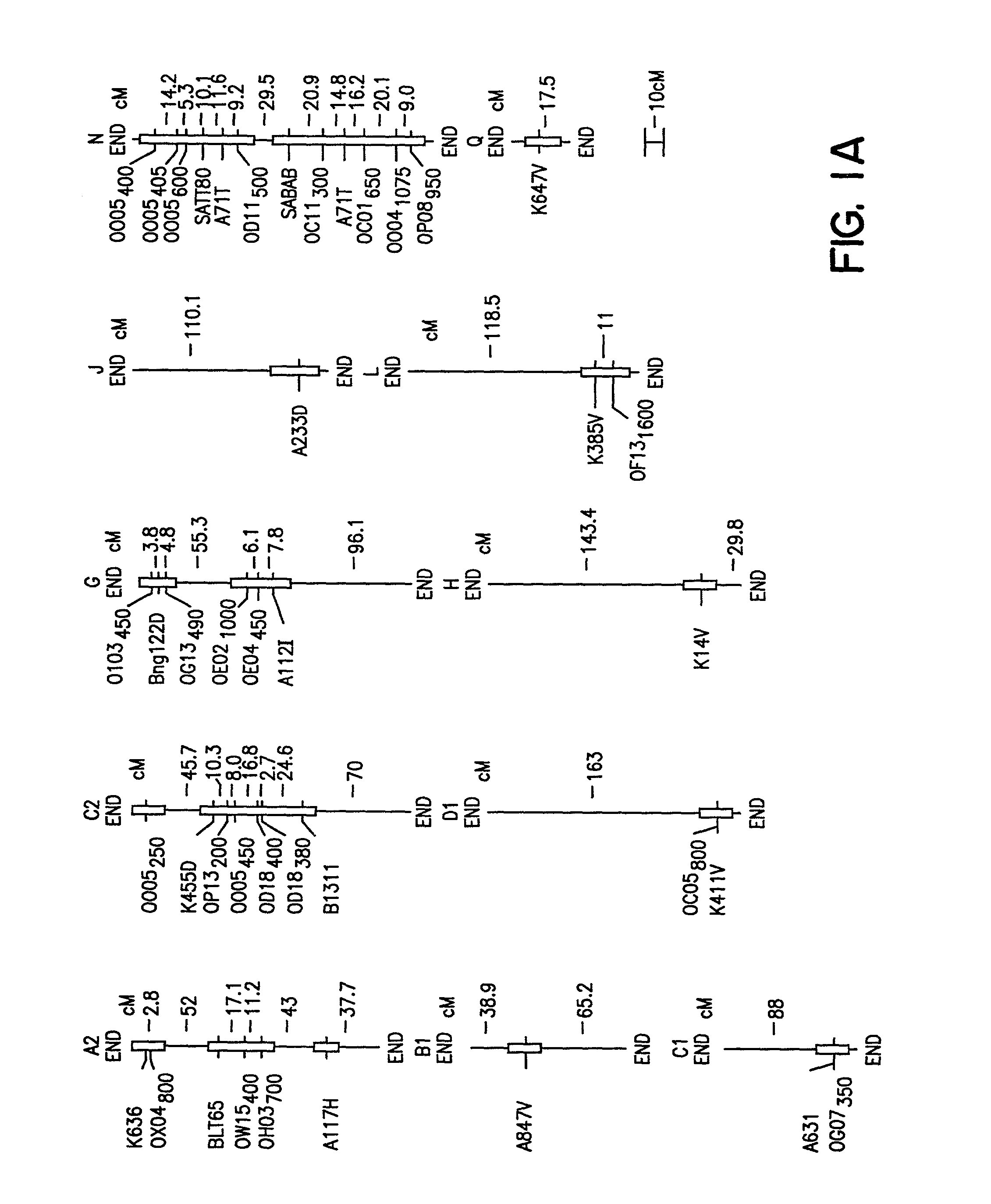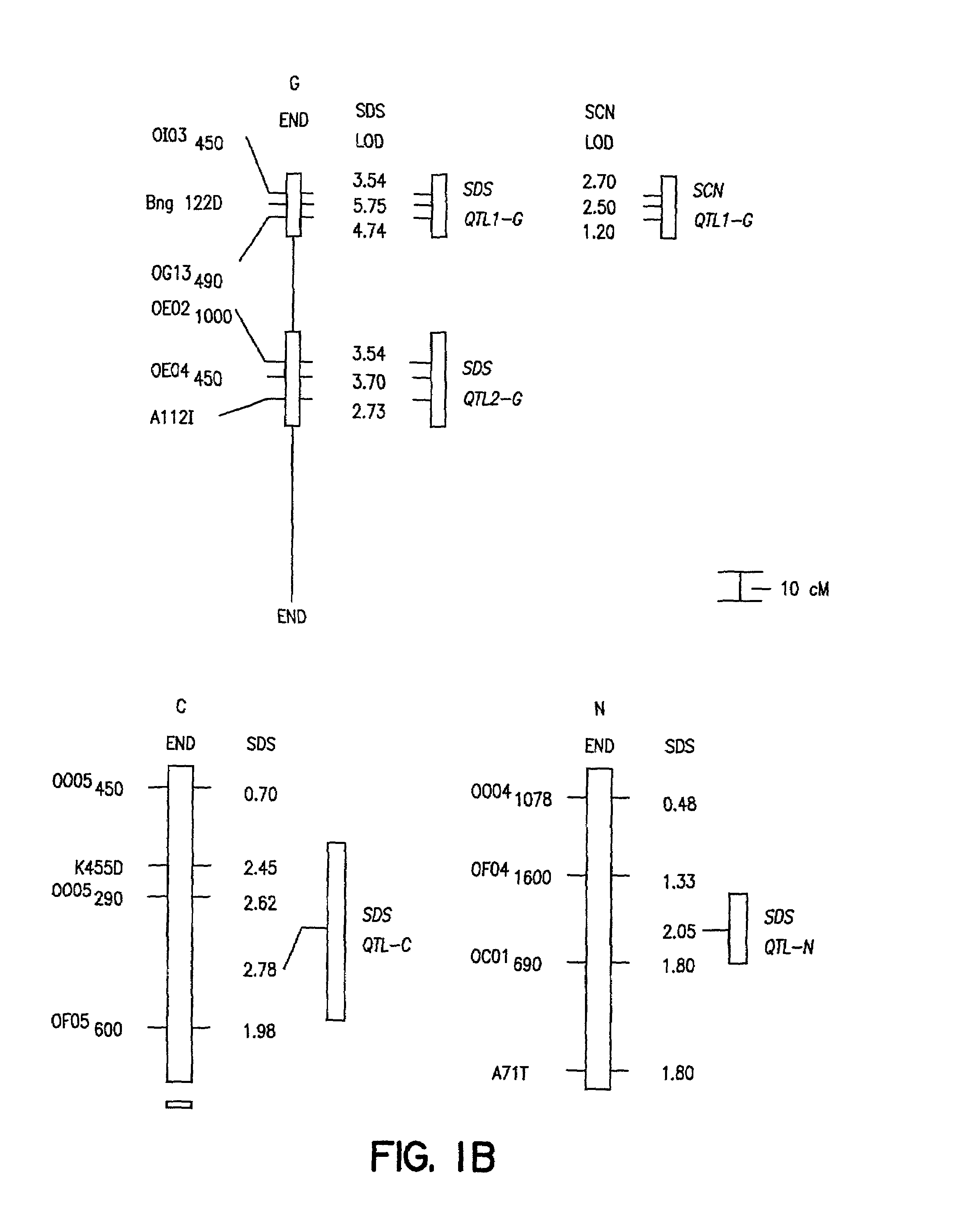Method of determining soybean sudden death syndrome resistance in a soybean plant
a sudden death syndrome and soybean technology, applied in the field of soybean and methods of soybean breeding, can solve the problems of uneconomical and environmentally sound use of fungicides as a control measure in soybean production, difficulty in breeding for soybeans, and production problems, and achieve the effects of improving the selection of resistant cultivars, enhancing the process of soybean breeding, and solving the problem of quickly and cheaply selecting resistant cultivars
- Summary
- Abstract
- Description
- Claims
- Application Information
AI Technical Summary
Benefits of technology
Problems solved by technology
Method used
Image
Examples
example 1
Identification of SDS Resistance Loci in Forrest and Essex
Materials and Methods
Plant Material
[0092]The ‘Essex’ by ‘Forrest’ (E×F)F5 derived population of soybean recombinant inbred lines (RILs) was constructed by crossing Essex (Smith and Camper, 1973) and Forrest (Hartwig and Epps, 1973). Essex is SDS susceptible, while Forrest is SDS resistant (FIG. 1B; Gibson et al., 1994). About 4500 F2 plants were inbred to the F5 generation using a single pod descent method. In year one, a random bulk of seed was planted to obtain 500 F5 plants of which 150 were randomly selected, only intentionally excluding a few agronomically undesirable extremes. In year two, 100 F5-derived lines of modal maturity (mid-maturity group V) with sufficient seeds for field testing were retained. All inbreeding occurred in fields with minimal incidence of soybean cyst nematode (SCN) and no history of SDS.
SDS Disease Scoring
[0093]Eight field experiments were conducted over a four year period encompassing a total ...
example 2
Identification of an SDS Resistance Locus in Forrest in the Greenhouse
Materials and Methods
[0107]Fusarium solani strain ST90, maintained on 5× Bilays medium at 19 C, was transferred onto PDA plates at 28 C for inoculum preparation. The 40 E×F RILs used were the 20 most resistant to SDS in the field and the 20 most susceptible to SDS in the field.
Infested Seed Assay
[0108]Plants were inoculated employing the infested oat technique (Stephens et al., 1993). Oats were soaked in tap water overnight, then excess water was strained away. The 150 ml portions were put into 250 ml Erlenmeyer flasks, capped, and autoclaved for 20 minutes. Oats were then cooled and three 1 cm2 agar plugs from the colony borders of F. solani petri plates were aseptically added to the sterilized oats. The inoculated oats were incubated in the dark at room temperature (24 C) for three weeks. Flasks were constantly shaken for uniform growth. Plants were grown in a soil medium containing a 1:1 (v / v) mixture of steril...
example 3
Identification of Two SDS Resistance Genes Close to a SCN Resistance Gene in Forrest
Materials and Methods
Plant Material
[0118]The cross of ‘Essex’ (Smith and Camper, 1973) by ‘Forrest’ (Hartwig and Epps, 1973) (E×F) was made and an F5 derived population of 100 RILs generated. During the studies described herein the RILs were advanced to the F5:13 generation from never less than 300 plants per generation. Essex is susceptible to both SDS and SCN, while Forrest is resistant to both SDS and SCN race 3 (Gibson et al. 1994; Hnetkovsky et al. 1996). The potential for unintentional natural selection for resistance to SDS or resistance to SCN was reduced by all inbreeding being carried out in fields with low incidences of soybean cyst nematodes (SCN) and no history of SDS symptoms.
[0119]Residual heterogeneity within RILs, theoretically 6.25%, was about 8% as detected by codominant markers at the F5:9 (Hnetkovsky et al. 1996; Chang et al. 1996). For the RFLP marker Bng122D six RILs that were ...
PUM
| Property | Measurement | Unit |
|---|---|---|
| temperatures | aaaaa | aaaaa |
| temperatures | aaaaa | aaaaa |
| temperatures | aaaaa | aaaaa |
Abstract
Description
Claims
Application Information
 Login to View More
Login to View More - R&D
- Intellectual Property
- Life Sciences
- Materials
- Tech Scout
- Unparalleled Data Quality
- Higher Quality Content
- 60% Fewer Hallucinations
Browse by: Latest US Patents, China's latest patents, Technical Efficacy Thesaurus, Application Domain, Technology Topic, Popular Technical Reports.
© 2025 PatSnap. All rights reserved.Legal|Privacy policy|Modern Slavery Act Transparency Statement|Sitemap|About US| Contact US: help@patsnap.com



